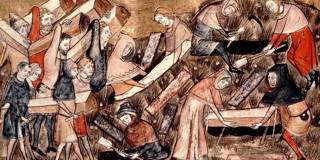Humankind has made so much progress in bending nature to our will that we sometimes forget our own place in it. The history of pandemics shows that the proverbial fourth horseman of the apocalypse – pestilence – can never be vanquished, only contained.
MILAN – In 1969, the US surgeon general, William H. Stewart, told Congress that it was time “to close the books on infectious diseases” and “declare the war against pestilence won.” Antibiotics, vaccines, and widespread advances in sanitation were making the world healthier than ever. Within a few years, the medical schools at Harvard and Yale actually closed their infectious-disease departments. By then, polio, typhoid, cholera, and even measles had essentially been eradicated, at least in the West.
But triumphalism was not only premature; it was dangerously foolhardy. The HIV/AIDS epidemic broke out in the United States just a decade later, and never has been vanquished. Then, following a short lull in the 1990s, came SARS, MERS, Ebola, Zika, and avian and swine flu, to name just a few of the outbreaks so far this century. Though most of these new diseases have primarily afflicted the poorest parts of the world, they should have made clear that the war on microbes was far from over.
Nonetheless, a sense of invulnerability has prevailed in the West. It was assumed that even if epidemics had not been consigned to history, they posed a risk only to geographically and economically distant societies. The novel coronavirus that emerged in Wuhan, China in December has shattered this illusion, showing once again that novel pathogens are equal-opportunity killers.

Mark Honigsbaum, The Pandemic Century: One Hundred Years of Panic, Hysteria, and Hubris, Hurst Publishers, 2019.
MILAN – In 1969, the US surgeon general, William H. Stewart, told Congress that it was time “to close the books on infectious diseases” and “declare the war against pestilence won.” Antibiotics, vaccines, and widespread advances in sanitation were making the world healthier than ever. Within a few years, the medical schools at Harvard and Yale actually closed their infectious-disease departments. By then, polio, typhoid, cholera, and even measles had essentially been eradicated, at least in the West.
But triumphalism was not only premature; it was dangerously foolhardy. The HIV/AIDS epidemic broke out in the United States just a decade later, and never has been vanquished. Then, following a short lull in the 1990s, came SARS, MERS, Ebola, Zika, and avian and swine flu, to name just a few of the outbreaks so far this century. Though most of these new diseases have primarily afflicted the poorest parts of the world, they should have made clear that the war on microbes was far from over.
Nonetheless, a sense of invulnerability has prevailed in the West. It was assumed that even if epidemics had not been consigned to history, they posed a risk only to geographically and economically distant societies. The novel coronavirus that emerged in Wuhan, China in December has shattered this illusion, showing once again that novel pathogens are equal-opportunity killers.